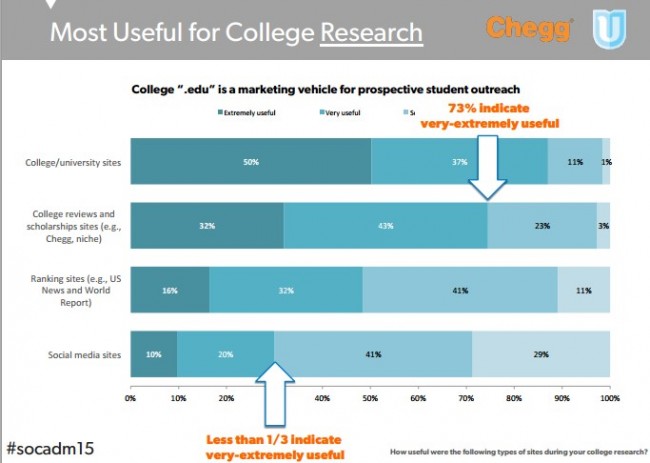Sponsors Chegg and Uversity recently released the 2015 Social Admissions Report. This report summarizes the results of their fall 2014 survey of 1611 high school seniors on their preferences and behavior with respect to researching, engaging with and ultimately selecting a post-secondary institution that they wish to attend.
The authors of this report have done a really nice job in the survey, striking well-structured questions as well as reporting their results with clear and engaging graphics. I recommend you download it and spend some time with it. There are some really valuable insights available here for any higher ed marketer interested in better understanding the thinking and behavior of this particular segment of their target prospective student audience.
One note about the data, the subjects of the survey are referred to as “Chegg students” which I believe means that they had created a profile in one of Chegg’s higher ed info websites, and were likely invited to participate as a result of that relationship, possibly even through its interface. This may skew the results a bit towards a type of student with a stronger affinity to web info tools and web research, so be careful not to extrapolate these results with too much certainty across other categories of students, say for example, certificate, MBA, graduate or part-timers. Having said that, this is still great research that can be very useful to you.
The report provides important insights about the role of social in higher education admissions but I think it also, just as importantly, reinforces some of the basic elements of digital marketing that higher ed marketers must wrestle into shape before moving on to tackle the complexities of social media marketing.
These basic elements of digital marketing are:
1) Your college or university website is the most important source of information about your institution
This should not come as a big surprise to anyone but it is amazing how often we find new clients get ahead of themselves about developing complex social media campaigns when they have not yet put their website in order. A well designed and implemented responsive, web site, built on best practices, will take you so much farther forward than the incremental gains you might get from any one particular campaign.

Source: 2015 Social Admissions Report
2) Your online presence must be 100% mobile friendly
Prospective students, particularly high school age, live on their mobile devices. Plain and simply, if your sites, preferably responsive, your content, your PPC, and your SEO are not completely mobile optimized, you are probably not even in the game.

Source: 2015 Social Admissions Report
3) Effective marketing is increasing all about communicating visually.
This report provides lots of insight into the changing preferences of high school prospects for social media platforms. I believe that the most important qualifier of which platform is “winning”, and which is “losing” lies in the degree to which they are, or are not, a visual medium.

Source : 2015 Social Admissions Report
The strongest overall growth in the last year is in YouTube and Instagram, two extremely visually oriented social channels. If you are not already thinking about it, start planning how to regularly create video content, and build up a strong video library both, as embedded files one your site and within an institutional YouTube channel. Expand your capabilities to produce graphics and good photography. You will be richly rewarded with increased student engagement and SEO points. Instagram seems like the “visual” channel that is charging ahead these days but if you look closely at Facebook and Twitter, the percentage of visual content on those channels has also dramatically increased over the last year and I would argue is helping keep them competitive.
The “Social” components discussed in the report provide some great insights into how to refine your social media strategy and footprint in the marketplace, but I would strongly argue that, particularly for those less experienced institutions who are still finding their way with digital marketing overall to really focus on the basics of digital marketing, and ensure that you have a strong foundation on which to build the social side of your online presence.
What insights have you found most interesting or most helpful from the 2015 Social Admissions Report. Is your experience reflected in their stats and insights?






